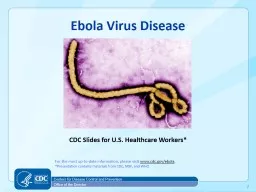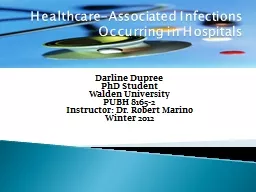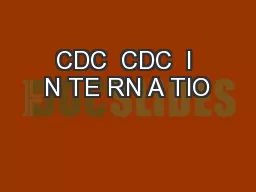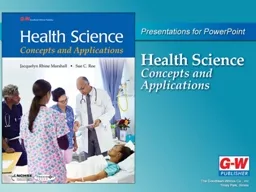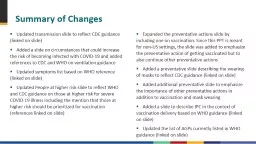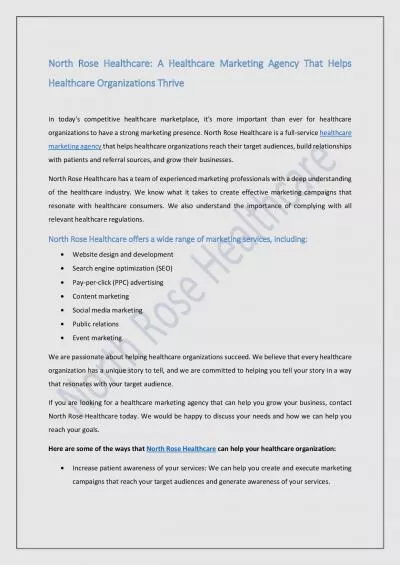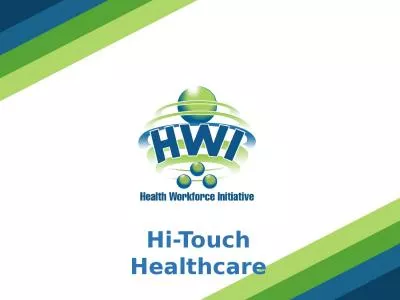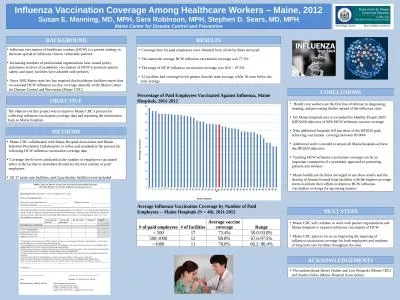PPT-CDC Slides for U.S. Healthcare Workers*
Author : liane-varnes | Published Date : 2020-04-04
Ebola Virus Disease Centers for Disease Control and Prevention Office of the Director For the most uptodate information please visit wwwcdcgovebola P resentation
Presentation Embed Code
Download Presentation
Download Presentation The PPT/PDF document " CDC Slides for U.S. Healthcare Workers*" is the property of its rightful owner. Permission is granted to download and print the materials on this website for personal, non-commercial use only, and to display it on your personal computer provided you do not modify the materials and that you retain all copyright notices contained in the materials. By downloading content from our website, you accept the terms of this agreement.
CDC Slides for U.S. Healthcare Workers*: Transcript
Ebola Virus Disease Centers for Disease Control and Prevention Office of the Director For the most uptodate information please visit wwwcdcgovebola P resentation contains materials from CDC MSF and WHO. brPage 1br Preparing Healthcare Workers to Work in Ebola Treatment Units ETU in Africa SAMPLE COURSE AGENDA brPage 2br brPage 3br Health Care Safety & Standard Precautions. Competency 1: Regulatory Agencies. Dede Carr, BS, LDA. Karen . Neu. , MSN, CNE, CNP. 1. U.S. Department of Labor Grant. “This workforce solution was funded by a grant awarded by the U.S. Department of Labor’s Employment and Training Administration. The solution was created by the grantee and does not necessarily reflect the official position of the U.S. Department of Labor. The Department of Labor makes no guarantees, warranties, or assurances of any kind, express or implied, with respect to such information, including any information on linked sites and including but not limited to, accuracy of the information or its completeness, timeliness, usefulness, adequacy, continued availability, or ownership. This solution is copyrighted by the institution that created it. Internal use, by and organization and/or personal use by an individual or non-commercial purposes, is permissible. All other uses require the prior authorization of the copyright owner.”. nfections . O. ccurring . in . Hospitals. Darline. Dupree. PhD Student. Walden University. PUBH 8165-2. Instructor: Dr. Robert Marino. Winter 2012. Hospital Board of Directors. OSHA. County Public Health Departments. NAL . I. M. PO. R. T. R. EG. U. L. A. TIO. NS. Cente. rs. . f. o. r. . Di. s. ea. s. e. . Cont. r. o. l. . an. d. . P. r. ev. ention. O. ff. i. c. e. . o. f. . Publ. i. c. . Health. . P. r. Discussion. In which areas must successful healthcare students have knowledge and skills?. oral and written communications. employability skills and teamwork. legal and ethical responsibilities. safety practices. Note the focus on financials, programs, and industry shorthand.. (Template) Insert Title. Insert Picture(s)/Charts here. 500K Limit. Product Type (Grocery, Dairy, Frozen, Bulk). Maximum . Unit Cost . Note the focus on financials, programs, and industry shorthand.. (Template) Insert Title. Insert Picture(s)/Charts here. 500K Limit. Product Type (Grocery, Dairy, Frozen, Bulk). Maximum . Unit Cost . This blog lists some of the best healthcare magazines that provide the most relevant information on the latest healthcare industry updates Dominant Leaders to Watch in Healthcare in 2021, speaks about the journey of some industry leaders and their disruptive tech solutions. Agenda. Introduction. Hand Hygiene. Reflection & Next Steps. Hand Hygiene. 2. Learning Objectives. Describe two (2) reasons . why having clean hands is especially important in healthcare. .. Discuss two (2) reasons . Added a slide on circumstances that could increase the risk of becoming infected with COVID-19 and added references to CDC and WHO on ventilation guidance . Updated symptoms list based on WHO reference (linked on slide). North Rose Healthcare has a team of experienced marketing professionals with a deep understanding of the healthcare industry. We know what it takes to create effective marketing campaigns that resonate with healthcare consumers. We also understand the importance of complying with all relevant healthcare regulations. hipAa. What to Expect in this Presentation. Ranking Professions. Definition and factors affecting ethics. Activity: Ethical . Donuts. Types of Ethical Dilemmas. Activity: Thought . Shower. Core Principles of Ethics. Susan E. Manning, MD, MPH, Sara Robinson, MPH, Stephen D. Sears, MD, MPH. Maine Center for Disease Control and Prevention. . Health care workers are the first line of defense in diagnosing, treating, and preventing further spread of the influenza virus.
Download Document
Here is the link to download the presentation.
" CDC Slides for U.S. Healthcare Workers*"The content belongs to its owner. You may download and print it for personal use, without modification, and keep all copyright notices. By downloading, you agree to these terms.
Related Documents

